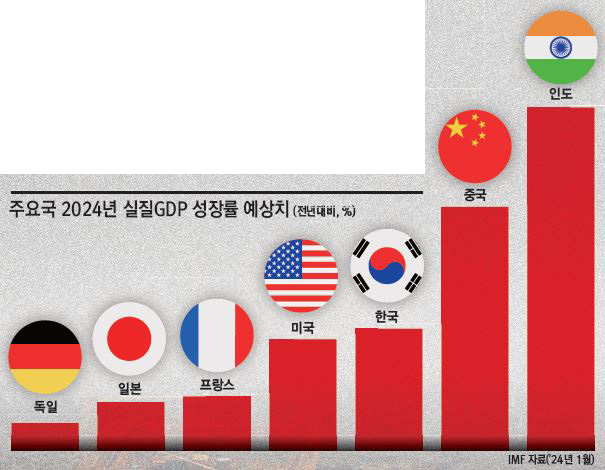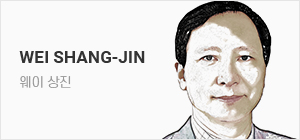이 기사는 해외 석학 기고글 플랫폼 '헤럴드 인사이트 컬렉션'에 게재된 기사입니다.
 |
| 춘절(春節) 연휴 기간인 지난 16일 빈저우시 선우네버나잇시티를 찾은 관광객들이 걷고 있다. 연휴 동안 중국 전역의 국내 여행이 지난해 같은 기간보다 34.3% 증가했다고 한다. |

As the Chinese stock market re-opens on February 19, after a 10-day celebration of the arrival of the Year of Dragon, investors will eagerly find out if strong market supportive measures will be put in place by the Chinese authorities. The real side of the Chinese economy did not do as well in the previous Year of Tiger (from January 22, 2023 to February 9, 2024) as many investment bank economists had predicted, with officially reported GDP growth of 5.2%, after first adjusting down the level of GDP in 2022. The Chinese stock market performed even worse, with its blue-chip index CSI experiencing a sad return of -11%, compared to a booming US stock market last year, with a return of 24%. As a Dragon symbolizes vitality, resilience, and good fortune, could the Chinese economy in the Year of Dragon demonstrate these same traits?
It is useful to put the recent Chinese economic performance in a global perspective. The global economy demonstrated remarkable resilience in the past 12 months. In particular, the United States has defied expectations and managed to avoid a recession in spite of a series of interest rate hikes to bring its CPI inflation down from 8% to 3% a year. This is no small feat. Historically, such disinflationary policies tend to produce a much weaker growth, including a recession.
The resilience of the US economy reflects four good fortunes of the country. First, the US Federal Reserve still enjoys credibility in the US society. When the US central bank announced a year ago that it intended to bring inflation down towards 2%, most corporate executives, labor leaders, and market participants believe that it will succeed. This facilitates a relatively painless adjustment. Second, while the wars in Ukraine and the Middle represent two big negative shocks to countries that have to import oil and gas and/or weapons, the US economy actually benefits from them as the United States is a significant net exporter of energy and the world‘s unrivaled weapons exporter. Third, given the concentration of global technology firms in the United States, the new wave of AI-fueled technology revolution has greatly boosted the US stock market. The rise in the US stock index, through a wealth effect, has in turn boosted the consumption demand from US households. Fourth, a wave of inward legal and illegal immigration, while it may be a short-term political problem for the sitting US president, has actually provided another boost to the US labor force, which helps to moderate the wage growth in the short run and will generate beneficial fruits for the US economy in the years to come.
As China lacks most of these features, the contrast in the economic performance between the world‘s two largest economies, relative to people’s expectations a year ago, cannot be more striking. Indeed, such comparison also contributes to a sense of optimism in the United States about its ability to withstand the economic costs of engineering a de facto economic decoupling from the Chinese economy. Both the comparison and the continued geopolitical pressure have contributed to the pessimistic commentary about the Chinese economy and stock market.
Several other emerging market economies, especially India and Vietnam, have also achieved impressive economic performance given the circumstances. But while these countries have good reasons to be optimistic about 2024, it is also worth noting that China will most likely be the single largest contributor to global GDP growth this year.
This may come as a surprise to many, given the wave of increasingly gloomy forecasts for the Chinese economy. But the logic will be made clear below. To be sure, China may not reach its full potential in 2024. Only by pursuing meaningful reforms and reaffirming economic openness (the two pillars of the country‘s remarkably successful growth model over the past four decades) can it regain its lost momentum.
The relative contribution of a country to the global GDP growth depends on both its share in the world economy and its relative economic growth. In purchasing-power-parity (PPP) terms, China‘s share of the world economy is 18.8% in 2023, compared to America’s 15.2%. By the International Monetary Fund projection, because the Chinese economy will grow by 4.6% in 2024 ― more than double the projected growth for the US ― China will likely account for a much larger share of global GDP growth than the US, despite its ongoing slowdown.
After a quarter-century of stagnation, Japan seems to be experiencing an economic revival. Having finally escaped the deflationary trap that ensnared its economy for more than three decades, the country is projected to grow by 1% in 2024. Nevertheless, its contribution to global growth will be more limited than either China or the US, owing to both its smaller share of the world economy and lower growth.
Meanwhile, the outlook for the United Kingdom and the European Union appears bleak. Barring an unexpected and unlikely resolution to the war in Ukraine in a short order, the best-case scenario for Europe‘s economy is that it will not impede global growth.
India, which is projected to grow by 7% this year, is expected to be the only major economy to grow faster than China. The geopolitical development has been favorable to India, enabling it to buy cheap Russian oil, get away from actions that would have been impossible if they were undertaken by China, and assert itself on the world stage. These favorable developments, together with domestic reforms pursued by Narendra Modi‘s government, have also led to a surge in foreign direct investment. But, because India’s share of the world economy is less than half of China‘s, its contribution to global growth will be smaller than that of China as well.
Similarly, developing countries such as Vietnam, Tanzania, Guyana, Gambia, Ethiopia, Djibouti, Côte d‘Ivoire, and Burkina Faso are projected to be growth stars in 2024. But all account for a very small share of the world economy.
Although China is expected to remain the largest contributor to global GDP growth, it could underperform relative to its growth potential ― which I estimate to be around 5.1% ― in 2024. Moreover, the positive spillover from the Chinese growth to other economies will also be more limited if the country‘s import growth does not return to the pre-pandemic levels.
China‘s main medium-term economic challenge is its shrinking workforce. Even if productivity growth remains constant, this demographic shift would put downward pressure on GDP growth. Given the current slump in the Chinese property sector, slower-than-expected household spending, and private-sector investment, the chances of another real-estate-driven economic boom appear slim.
But the greatest threat facing the Chinese economy today is a fall into a debt-deflation trap. Because deflation increases the real value of existing debts, banks could become increasingly reluctant to provide loans to businesses and local governments. As indebted households and businesses cut their spending, the toxic combination of debt and deflation could trigger a vicious cycle of lower investment and reduced demand.
Chinese monetary authorities‘ reluctance to adopt a more expansionary monetary policy is unhelpful. While the People’s Bank of China (PBOC) and the country‘s banking regulator have set key performance indicators on loan scale to stimulate lending, state-owned commercial banks often meet these targets by providing loans to unproductive state-owned enterprises (SOEs) that do not require urgent financing as much as many non-state-owned enterprises.
In fact, SOEs typically receive loans at lower interest rates than the rates on the banks‘ wealth-management products. Instead of investing these funds in productive projects, they often redeposit them for a higher interest rate, allowing the banks to re-lend to the same SOEs. While this process inflates the banks’ reported loan and deposit figures, creating the appearance of effective monetary policy, such practices do little to boost production, employment, and tax revenues in the economy.
To avoid a deflation-debt spiral, Chinese policymakers must urgently inject more liquidity into the economy. But for the lending channel to work effectively, China must reform its state-owned banks to ensure that financial institutions focus on profitability and lend to the most productive firms, rather than creating artificial money flows. Unfortunately,, China is unlikely to undertake these critical reforms anytime soon.
There is an alternative policy package in the short run. Chinese policymakers could pair an aggressive fiscal policy with the monetization of government debt. This means a three-step plan. First, fiscal policy could focus on building low-income housing, upgrading public infrastructure, and settling the outstanding debts of local and national government agencies to private-sector firms. Second, these expenditures can be funded through the issuance of new long-term government bonds. Lastly, the PBOC should purchase these bonds and hold them until maturity, or at least until the economy returns to its potential growth rate.
With the more expansionary monetary policy in the short run and structural policy reforms in the medium run, the Chinese economy can move closer to its full growth potential. The stronger fundamentals will give a much needed boost to the Chinese stock prices that should be as important as any direct interventions in the stock market.

중국 경제, 생명력·행운 잡을 수 있나
용의 해를 맞이하는 10일 간의 연휴가 끝나는 2월 19일 중국 주식시장이 다시 개장함에 따라 투자자들은 중국 당국이 강력한 시장 지원 조치를 취할 것인지 관심이 많을 것이다. 2022년 처음으로 국내총생산(GDP) 수준을 하향 조정했던 중국 실물 경제는 지난 호랑이 해(2023년 1월 22일~2024년 2월 9일)에도 많은 투자은행 경제분석가들이 예측했던 대로 좋은 성과를 거두지 못하며 공식적으로는 5.2%의 GDP 성장을 기록했다. 또, 작년 미국 증시가 호황을 누리며 24%의 수익률을 기록하는 동안, 중국 증시는 우량 지수인 CSI마저 -11%라는 우울한 수익률을 기록하며 상황이 더 안 좋았다. 이제 생명력, 회복력, 행운을 상징하는 용의 해가 도래한 만큼 중국 경제가 이런 용의 모습을 보여줄 수 있을까.
중국 경제의 최근 성과를 글로벌 관점에서 살펴보자. 지난 12개월 동안 세계 경제는 놀라운 회복력을 보여줬다. 특히, 미국은 소비자물가지수(CPI) 인플레이션을 8%에서 3%로 낮추기 위한 여러 번의 금리 인상에도 사람들의 예상을 깨고 경기 침체를 피해갔다. 이는 결코 사소한 일이 아니다. 역사적으로 이러한 디스인플레이션(Disinflation·물가 수준은 여전히 높지만 물가상승률 자체는 둔화) 정책은 보통 경기 침체를 포함해 훨씬 더 부진한 성장을 가져왔기 때문이다.
미국 경제의 회복력은 미국이 가진 네 가지 행운을 반영한다. 첫째, 미국 사회는 여전히 미국 연방준비제도를 신뢰한다. 1년 전 미국 중앙은행이 인플레이션을 2%까지 낮추겠다고 발표했을 때 대부분의 기업 임원과 노동계 지도자 및 기타 시장 참여자들이 연준을 믿었고, 덕분에 비교적 덜 고통스럽게 조정을 실행할 수 있었다. 둘째, 우크라이나와 중동에서 벌어지고 있는 전쟁은 석유, 가스, 무기를 수입해야 하는 국가에게는 대단히 부정적인 쇼크이지만, 에너지 주요 순 수출국이자 세계 최대 무기 수출국인 미국 경제에는 사실 이득이다. 셋째, 글로벌 기술 기업들이 미국에 집중돼 있는 상황에서 AI를 기반으로 한 새로운 기술 혁명의 물결은 미국 주식시장을 크게 끌어올렸고, 이러한 미국 주가 지수의 상승은 부의 효과(또는 자산 효과)를 통해 다시 미국 가계의 소비 수요를 끌어올렸다. 넷째, 미국으로 밀려드는 합법 및 불법 이민자들은 현직 미국 대통령에게는 단기적인 정치적 문제일 수 있지만 사실상 미국 노동시장에 활력을 불어넣었고, 이는 단기적으로는 임금 상승을 완화하고 향후에는 미국 경제가 이로운 결실을 맺게 해줄 것이다.
중국에는 이러한 행운이 대부분 없었기 때문에 1년 전 사람들의 기대와 비교했을 때, 현재 세계 양대 경제대국의 경제적 성과는 극명하게 대비된다. 실제로 이러한 비교는 미국이 중국 경제와 사실상 디커플링하는 데 드는 경제적 비용을 견딜 수 있을 거라는 낙관론에 힘을 실어주고 있다. 또한, 미국과 대비되는 상황 및 지속적인 지정학적 압력으로 인해 중국 경제와 증시에 대한 비관적인 논평들이 나오게 됐다.

인도와 베트남 등의 일부 기타 신흥국들도 상황 대비 인상적인 경제적 성과를 달성했다. 이 국가들은 2024년에 대해 충분히 낙관적인 전망을 할 수 있긴 하지만, 우리는 2024년에도 계속해서 중국이 글로벌 GDP 성장에 가장 큰 기여를 하는 국가가 될 가능성이 높다는 점을 주목해야 한다.
이는 중국 경제에 대한 어두운 전망이 쏟아져 나오는 상황에서 놀라울 수 있다. 이에 대한 논리는 아래에서 명확하게 설명이 될 것이다. 물론 중국이 2024년에 최대 잠재력을 완전히 다 실현하지 못할 가능성도 있다. 지난 40년 동안 중국의 놀랍도록 성공적인 성장 모델의 두 축이었던 유의미한 개혁과 경제 개방에 대한 재확인이 있어야만 중국은 잃어버린 추진력을 회복할 수 있을 것이다.
글로벌 GDP 성장에 대한 한 국가의 상대적 기여도는 그 국가가 세계 경제에서 차지하는 비중과 그 국가의 상대적 경제 성장률에 의해 결정된다. 구매력평가지수(PPP) 기준, 2023년 중국이 세계 경제에서 차지하는 비중은 18.8%, 미국은 15.2%였다. 국제통화기금(IMF)은 2024년에 중국 경제가 4.6% 성장할 것으로 전망하고 있는데, 이는 미국 경제에 대한 성장률 전망보다 두 배 이상 높다. 그렇기 때문에 중국이 경기 둔화에도 글로벌 GDP 성장에 미국보다 훨씬 더 많은 기여를 할 가능성이 높은 것이다.
일본 경제는 25년 간의 경기 침체를 겪은 후 이제 다시 살아나고 있는 것으로 보인다. 30년 넘게 일본 경제의 발목을 잡고 있던 디플레이션의 덫에서 마침내 탈출한 일본은 2024년 1% 성장할 것으로 예상된다. 그렇지만, 일본은 중국과 미국에 비해 세계 경제에서 차지하는 비중도 작고 성장률도 낮기 때문에 글로벌 경제 성장에 기여하는 바가 제한적일 것이다.
한편, 영국과 유럽연합(EU)에 대한 전망은 암울하다. 우크라이나 전쟁이 예상을 깨고 갑자기 단기간에 해결되는 일이 벌어지지 않는 한, 유럽 경제에 대한 최선의 시나리오는 글로벌 성장을 방해하지만 않는 것이다.
올해 7% 성장이 예상되는 인도는 유일하게 중국보다 빠르게 성장하는 주요 경제국이 될 것으로 보인다. 지금까지 지정학적 상황이 인도에 유리하게 전개돼 인도는 값싼 러시아산 원유를 구매하는 등 중국이었다면 제재를 피하는 게 불가능했을 행동을 하고도 제재를 받지 않은 채 세계 무대에서 자기 목소리를 내고 있다. 이런 유리한 상황에 나렌드라 모디 정부의 국내 개혁이 더해져 외국인 직접 투자도 급격하게 늘어났다. 그러나 인도가 세계 경제에서 차지하는 비중은 중국의 절반도 되지 않기 때문에 글로벌 성장에 대한 인도의 기여도 역시 중국보다 작을 것이다.
인도와 마찬가지로 베트남, 탄자니아, 가이아나, 감비아, 에티오피아, 지부티, 코트디부아르, 부르키나파소와 같은 개발도상국들도 2024년에 급성장할 것으로 예상된다. 그러나 이 국가들은 모두 세계 경제에서 차지하는 비중이 매우 작다.
 |
| 중국 동부 장시성 난창 국제 내륙항에서 크레인이 컨테이너를 들어올리고 있다. |
이렇게 중국은 2024년에도 여전히 글로벌 GDP 성장에 가장 큰 기여를 할 것으로 보이지만, 중국의 성장 잠재력(필자는 약 5.1%로 추정)에 비해서는 성과가 저조할 수 있다. 또한, 중국의 수입 증가율이 팬데믹 이전 수준으로 돌아가지 않는다면 중국의 성장이 다른 국가에 미치는 긍정적인 파급 효과 또한 약해질 것이다.
중국이 직면한 중요한 중기적 문제 중 하나는 인력 감소다. 생산성이 꾸준하게 증가하더라도, 이러한 인구통계학적 변화는 GDP 성장에 하방 압력을 가할 것이다. 또한, 중국 부동산 시장의 침체와 예상보다 부진한 가계 지출 및 민간 투자를 고려했을 때, 부동산을 중심으로 한 경기 호황이 다시 올 가능성은 희박하다.
그러나 현재 중국 경제가 직면한 가장 큰 위협은 부채-디플레이션의 덫에 빠지는 것이다. 디플레이션은 기존 부채의 실질 가치를 증가시키기 때문에 은행은 기업과 지방 정부에 대출 제공하기를 점점 꺼리게 될 수 있다. 빚을 진 가계와 기업이 지출을 줄임에 따라, 부채와 디플레이션의 유독한 결합은 투자 감소와 수요 감소라는 악순환을 촉발할 수 있다.
중국 통화당국이 확장적 통화정책 채택을 꺼리는 건 도움이 되지 않는다. 중국 인민은행과 중국의 은행 규제당국이 대출 활성화를 위해 대출 규모에 대한 핵심성과지표를 설정했지만, 중국의 국유 상업은행들은 종종 민간기업만큼 긴급한 자금 조달의 필요가 없는 생산성 낮은 국유기업에 대출을 제공하여 이 목표를 채우곤 한다.
실제로 국유기업들은 시중 은행의 자산관리상품보다 낮은 금리로 대출을 받는다. 그 후 이 자금을 생산적인 프로젝트에 투자하는 대신 국유기업들은 종종 더 높은 이자를 주는 상품에 재예치하고, 은행은 다시 이 자금을 동일한 국유기업에 대출해 준다. 이 과정에서 은행이 보고하는 대출과 예금 금액이 늘어나 통화 정책이 효과가 있는 것처럼 보이게 만들지만, 사실 이러한 관행은 생산성 증대, 고용 창출 및 세수 증대에 거의 도움이 되지 않는다.
중국의 정책입안자들은 부채-디플레이션 악순환을 피하기 위해 시급히 경제에 더 많은 유동성을 투입해야 한다. 그러나 대출 채널이 효과적으로 작동하려면 국유은행들을 개혁해 금융기관으로 하여금 인위적인 자금 흐름을 만들어내는 것이 아니라 수익성에 중점을 두고 가장 생산적인 기업에 대출을 해주도록 해야 할 것이다. 안타깝게도 중국이 이 중요한 개혁을 조만간 착수할 가능성은 낮다.
단기적으로 쓸 수 있는 대안적인 정책 패키지가 존재하긴 한다. 바로 공격적인 재정 정책과 정부 부채의 화폐화를 병행하는 것인데, 이를 위해서는 3단계 계획이 필요하다. 1단계, 재정 정책은 저소득층 주택 건설, 공공 인프라 개선 및 지방과 중앙 정부기관이 민간 기업에 지고 있는 부채를 청산하는 것에 중점을 둔다. 2단계, 이에 필요한 지출은 신규 장기 국채 발행을 통해 조달한다. 마지막 단계로 인민은행은 이 채권을 구매해 만기까지 또는 적어도 경제가 잠재성장률 수준으로 돌아올 때까지 보유한다.
단기적으로 확장적 통화정책을 쓰고 중기적으로 구조적인 정책 개혁을 추진한다면 중국 경제는 최대 성장 잠재력에 가까워질 수 있고, 그 결과 강해진 펀더멘털은 주식시장에 직접 개입하는 것만큼이나 중국 증시를 크게 끌어올릴 수 있을 것이다.
웨이 상진 미국 컬럼비아대학교 경영대학원 중국 비즈니스 경제학 교수
















